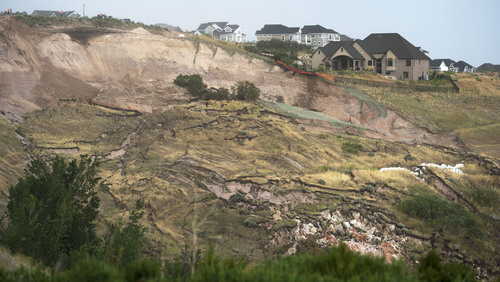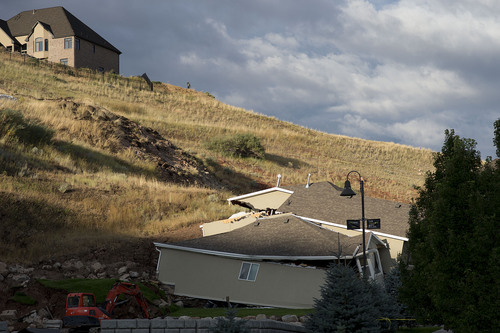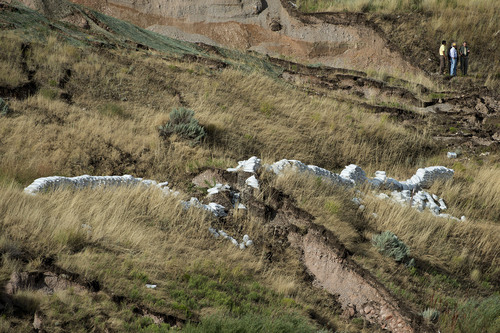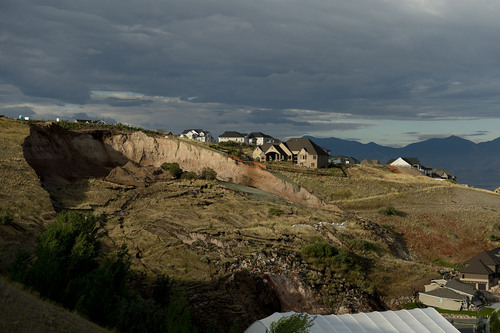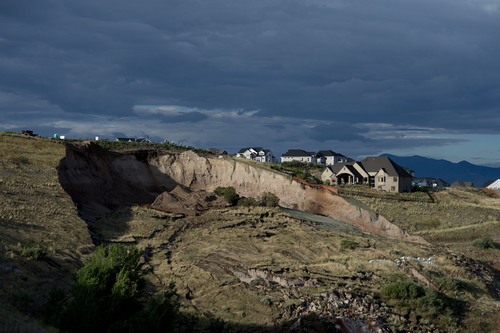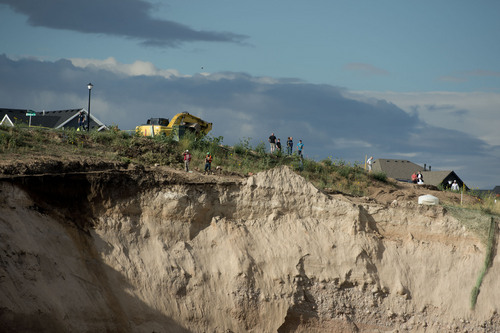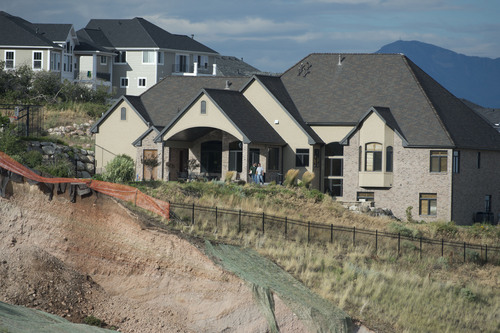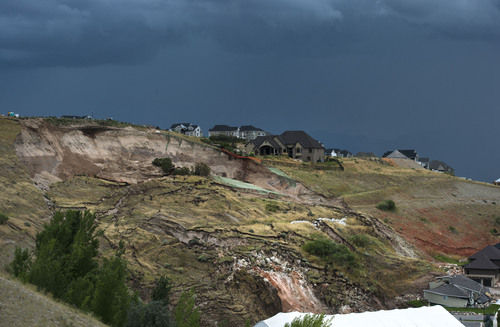This is an archived article that was published on sltrib.com in 2014, and information in the article may be outdated. It is provided only for personal research purposes and may not be reprinted.
When would-be homeowners see a house on a hill — or at the bottom of a hillside — they assume it's safe; certain that regulators have made sure there is no hazard.
But that isn't always the case. And when things go wrong, residents wonder how it was allowed to happen — particularly when a landslide, like the one last week at Eaglepointe Estates in North Salt Lake, is at the site of a former gravel quarry resting upon claylike soils.
In Utah, state law puts the onus for safe development squarely on the shoulders of local government. In some cases, like North Salt Lake today and Draper 15 years ago, smaller cities that are growing rapidly face challenges they may not have fully envisioned.
"The smaller the community, the smaller the resources for planning," said Jim Schwab of the Chicago-based Hazards Planning Research Center. "Those places are more dependent on the state for guidance."
While the Utah Geological Survey (UGS) does offer direction to cities on such matters — including how to craft a hillside-building ordinance — the agency does not have the resources to study specific proposed developments, said UGS deputy director Kimm Harty.
In an effort to aid cities, then-Gov. Jon Huntsman commissioned Utah experts to issue a 2007 report, called "Recommendations of the Governor's Geological Hazards Working Group." It urged municipalities to strengthen practices beyond simply accepting a report from a consultant hired by a developer. The stated goal: "to encourage local governments to understand their exposure to geologic hazards, evaluate their risk, and develop a plan to reduce their risk where necessary."
—
It's the law • When developers come knocking, it means an increase in property tax base for a city and, most likely, sales tax revenues down the line, because retailers follow rooftops.
And when builders produce geotechnical reports declaring a development safe, the burden under Utah law is on the city to show why those landowners can't exercise their property rights.
"If someone comes with an application for development that complies with the zoning in place and a geotechnical report that shows the soil to be safe, the city has to approve it," explained Brent Bateman, lead attorney for Utah's Office of the Property Rights Ombudsman. "If the city doesn't say yes and it is safe, a 'taking' may have occurred."
Such an instance of "taking," or depriving owners of property rights, could leave the municipality liable for financial damages.
But there is an exception, Bateman noted: "A compelling countervailing public interest" — that is, if further analysis deems the proposed development unsafe.
Sky Properties provided North Salt Lake with an in-depth geotechnical report on Eaglepointe Estates from consultants the development firm hired. The 2003 document by California-based Applied Geotechnical Engineering Consultants Inc., determined, among other findings, that the Eaglepointe hillside "is suitable for the proposed residential development."
—
Red flag • The report added a caveat: "Based on [geologic hazard] maps, a more detailed study on portions of the proposed development is suggested for surface fault rupture, landslide and debris flow."
That, said UGS' Harty, is a "red flag."
"If the report says you can build there but there are things you should study further, that's a warning to me," she said. "The city and developer should look at it further."
Sky Properties, in fact, commissioned a follow-up analysis on the hillside that slid Tuesday. A 2013 report from Salt Lake City-based GSH Geotechnical Inc. found the hill to be "globally stable."
North Salt Lake officials say they followed the law and recommended protocols, including independent reviews of the geotechnical reports supplied by the developer.
"I don't know how we could have predicted or prevented something like this," said City Councilman Conrad Jacobson. "We're grasping at straws as to what more we could do and how we face the future."
Predicting exactly when and how a landslide will occur is practically impossible, said Jeff Moore, University of Utah professor of geology and geophysics. But he noted that some lands at Eaglepointe were "continuously disturbed" in the years it served as a gravel quarry, adding to potential instability.
"The final failure is unpredictable," he said of Tuesday's slide. But, he added, a large crack in the ground opened at the crown of the slide a week before it let loose.
Rain in the area may have helped trigger the slide, Moore said. But if it had occurred in April, when soils are much wetter, the slide could have been a lot worse.
—
Learning the hard way • Although geological hazards on hillsides are not uncommon along the Wasatch Front, Draper has suffered more than its share.
But after the southern Salt Lake County city had approved hundreds of building lots along a wide swath of Traverse Ridge, including the SunCrest development, it found that much of the hillside was unsuitable for building.
Crumbling roadways and utility lines led the city to rescind building approvals. That spawned numerous lawsuits that persisted for years.
Today, Draper has one of the state's best hillside-building ordinances, according to UGS officials.
Harty noted that the city's statute is the outcome of the development problems it faced on Traverse Ridge and elsewhere.
"They were under pressure from developers [to approve projects]" she said. "[But] when they started to have problems, that's when they started to require a more thorough investigation."
The ordinance is multifaceted, explained Russell Fox, assistant city manager. The Draper regulations outline numerous specifics that must be met, including "trenching" to analyze the exact makeup of the soils. Not only does Draper hire its own geologists to review a developer's geotechnical report, it also requires the city's hired experts to be on hand when the trenching is performed and to evaluate the analysis rendered by the developer's team.
But young cities often don't learn from the mistakes of those that came before them, said Stephen Goldsmith, U. professor of city and metropolitan planning. Just because a city is small does not relieve it of its responsibility for good planning, he said.
Good planners should be like doctors, Goldsmith added, in that their first duty is "to do no harm," while keeping in mind that they are working for the community, not the developer.
Nonetheless, little cities and big ones across the country tend to look at land as real estate, rather than as an environment to be protected, said Goldsmith, Salt Lake City's former planning director. That overriding philosophy allows planners and developers to move forward with projects, unless they can be shown as harmful.
Goldsmith said he would like to see a shift toward responsibility for the environment.
"In the European Union, they use the precautionary principle: We will not balance on the backs of citizens things that haven't been proved safe," he said. "Here, we continue to balance on citizens' questions [of safety] that haven't been answered."



